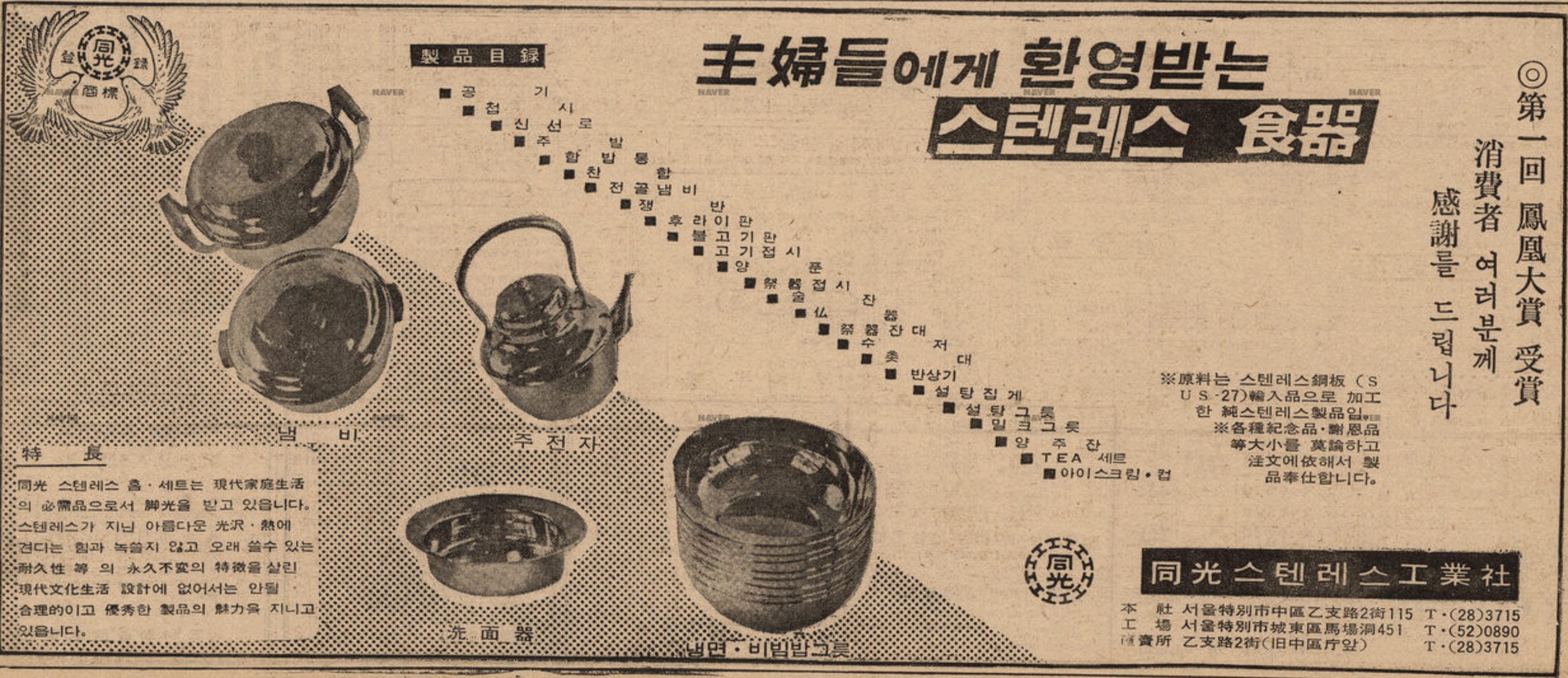최지원
1950-80년대 한국 스테인리스 식기의 출현과 전용
서울대학교 디자인역사문화 전공 석사학위논문 (2024)
이 연구는 1950-80년대 한국 스테인리스 식기의 출현과 변천사를 살펴 봄으로써 식기라는 일상 사물이 물질적 · 역사적 · 정치 사회적 맥락 위에서 한국 사회의 일면을 어떻게 담아내고 있는지 고찰하는 것을 목적으로 한다.
소재로써 스테인리스강은 20세기 초 유럽에서 처음 개발된 직후 비부식성을 장점으로 내세워 식기로 주조되었으나, 세계대전 발발을 계기로 전쟁 수행에 필수적인 재료로 재인식되었다. 반세기 가까이 전 세계를 잠식한 전 쟁 상황 속에서 스테인리스강은 6.25 전쟁을 계기로 한국 사회에 본격적으 로 유입되기 시작했다. 미군 부대를 통해 유입된 스테인리스 군용 물품이 본래의 용도를 넘어 한국인의 일상생활 영역으로 흘러들어왔고, 그 일련의 흐름은 한국 스테인리스의 출현과 밀접한 상관관계를 지니고 있었다.
전쟁 이후 재정적으로 번성하던 미국 철강 산업이 세계대전 이후 급격히 수축했고, 미국 철강 업계의 부진을 틈타 한국을 비롯한 신흥개발국의 철강 제품 수출 산업이 크게 성장했다. 1960년대 이후 세계 각국으로부터 한국 금속 양식기에 대한 수요가 발생하기 시작했고 이후 수출용 금속 양식기는 산업 수출의 역군으로 손꼽히며 본격적인 수출 가도를 달리기 시작했다.
이후 한국의 양식기 제조 기업들은 기술 개발부터 시설 근대화, 디자인 다양화에 이르기까지 스테인리스 양식기를 고급화하기 위한 노력을 다각도에서 전개했으나, 산업을 둘러싼 대내외적 상황의 악화로 수출용 금속 양식기는 점차 경쟁력을 잃었다. 반면 같은 시기 한국에서 스테인리스 식기는 재료의 물성을 내세워 사치품의 지위를 획득했다. 스테인리스가 그 자체로 질 좋은 재료였기 때문이라기보다 당시 한국 사회를 휩쓴 주거 및 주방 문화의 변혁기 속에 스테인리스 식기가 자리하고 있었기 때문에 가능한 것이었다.
1980년대 이후부터 기업들은 조리용 스테인리스 식기 개발에 적극적으 로 나서며 시장 개척에 나섰다. 당시 기업들이 앞다투어 내놓은 대표적인 제품은 스테인리스 김칫독과 김치통, 그리고 압력솥이었는데, 모두 현대화된 주방 공간에서 설 자리를 잃은 전통적인 주방 기구를 대신하는 것들이었다. 이처럼 1980년대의 스테인리스 식기는 이전 세대의 유기와 은식기의 자리 를 대체하는 것을 넘어 1970-80년대 주방 근대화와 식문화 변화 흐름을 적극적으로 투영하고 있었다. 근대화된 주방 공간에서 새롭게 설 자리를 찾은 스테인리스 식기는 1980년대 정부 주도하에 전국적으로 대두된 위생 담 론과 식생활 개선 운동에 편승해 대중음식점의 영역까지 나아갔다. 추상적인 정책과 제도는 스테인리스 식기라는 평범한 사물을 매개로 구체화하여 개인의 삶과 일상에 실질적이고 물리적인 영향을 끼칠 수 있는 힘을 갖게 되었다.
이 연구를 통해 일상 사물로써 스테인리스 식기가 재료와 사물, 제도와 담론을 매개하며 사회문화적 가치를 부여받는 과정을 살펴보고자 하였다. 종종 몰개성하고 무가치하게 여겨지는 공산품을 디자인사 관점에서 주목하는 시도는 평범한 사물이 개인과 사회를 변형할 수 있는 힘을 지니고 있음 을 인지하는 데에 도움이 된다. 스테인리스 식기에 대한 디자인사적 접근을 시도한 이 연구가 한국 디자인사에서 일상 사물에 대한 관심과 이해를 증진 하는 계기가 되기를 기대한다.
주요어 : 스테인리스, 식기, 산업화, 일상용품, 사물
Jiwon CHOI
The Advent and Convert of Korean Stainless Steel Flatware in 1950-1980
This study aims to examine the emergence and transformation of stainless-steel tableware in Korea during the 1950s to the 1980s to explore how an everyday object reflects a facet of Korean society in its material, historical, and political-social context.
Stainless-steel was first developed in Europe in the early 20th century and immediately made into tableware touted as an advantage of non-corrosive properties. But with the outbreak of World War I, it was rediscovered as an essential material for warfare. After nearly half a century of war that engulfed the world, stainless-steel began to enter Korean society in ear nest with the Korean War. The influx of stainless-steel military goods from the U.S. military was closely correlated with the emergence of Korean stainless steel, as the material moved beyond its original use and into the realm of everyday Korean life.
After the war, the financially prosperous U.S. steel industry sharply contracted after World War II and the steel product export industry in emerging and developing countries, inclu ding South Korea, grew significantly to capitalize on the decline of the U.S. steel industry. Since the 1960s, demand for Korean stainless-steel flatware has been generated from all over the world, and stainless-steel flatware for export has been one of the mainstays of industrial exports.
Since then, Korean tableware manufacturers have made various efforts to upgrade their stainless-steel tableware , from technological development to modernization of facilities to diversification of designs, but due to the deterioration of internal and external conditions surrounding the industry, metal tableware for export gradually lost its competitiveness. However, at the same time in Korea, stainless-steel tableware gained the status of a luxury item due to its material properties. This was not because stainless steel was a quality material in itself, b ut rather because it was p ositio ned in the mid st of the residential and kitchen cultural transformation that was sweeping Korean society at the time.
From the 1980s onward, companies began to actively develop stainless steel utensils for cooking, and the most prominent products were stainless-steel kimchi jars, kimchi containers and pressure cookers, all of which replaced traditional utensils that had lost their place in the modernized kitchen space. In this way, stainless-steel appliances in the 1980s were not only replacing the previous generation's brassware and silver utensils, but also actively projecting the trend of kitchen modernization and food culture change in the 1970s and 1980s.
Finding a new place in the modernized kitchen space, stainless steel utensils also found their way into restaurants in the 1980s, capitalizing on the government-led national discourse of hygiene and the movement to improve eating habits. It was the small, unassuming, everyday object of stainless-steel utensils that created the conditions for the state to internalize the new administrative regime into the individual. Abstract policies and institutions were materialized through the medium of an ordinary object, the stainless steel utensil, and gained the power to have a real and physical impact on the lives and daily routines of individuals.
keywords: Stainless-steel, Flatware, Industrialization, Everyday supplies, Object



